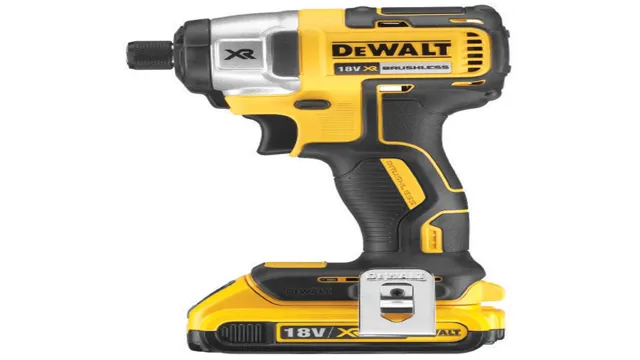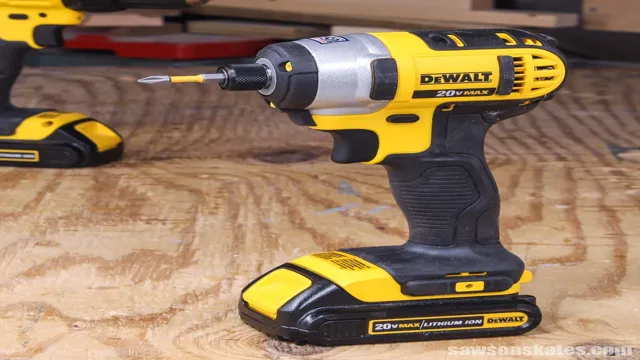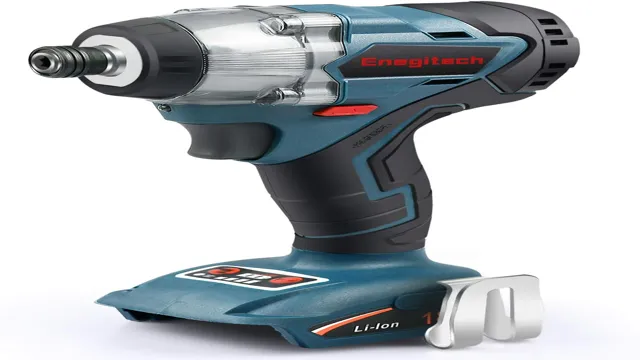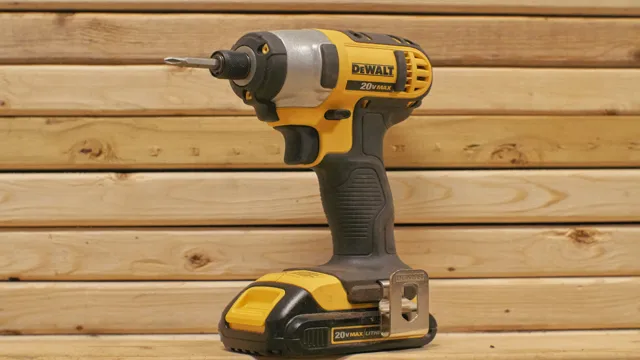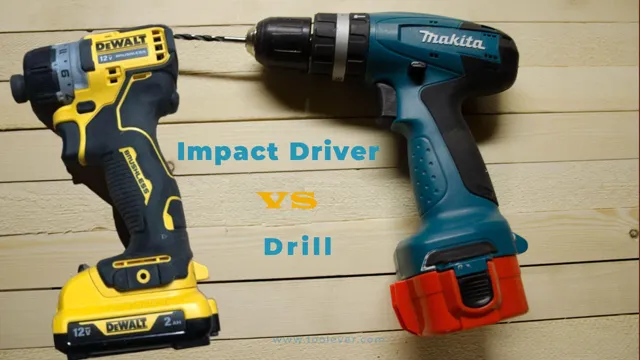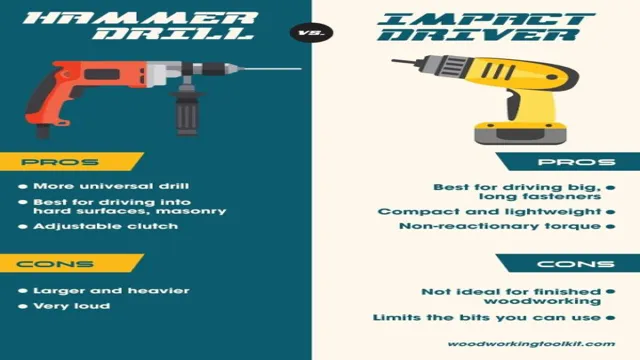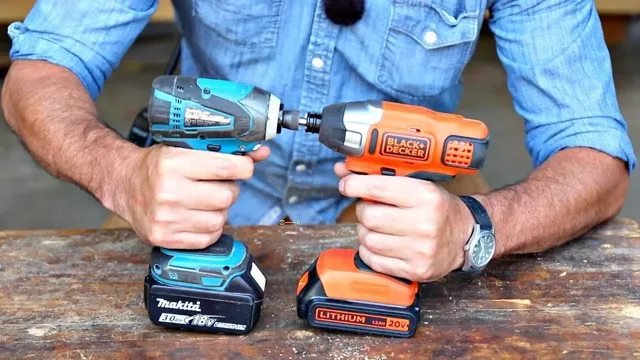Why Impact Driver Over Drill: Benefits and Differences Explained
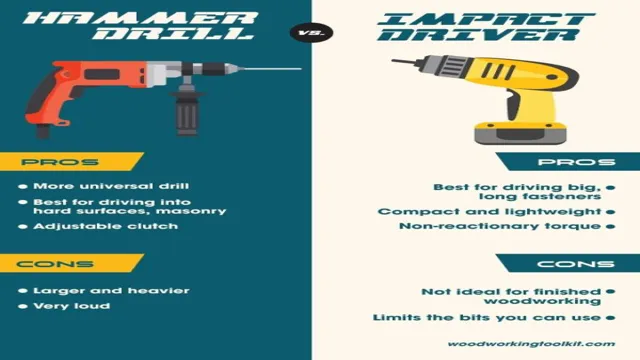
When it comes to power tools, having the right tool for the job can make all the difference. Two popular options for DIYers and professionals alike are impact drivers and drills. But which is better? At first glance, they may seem interchangeable.
After all, they both have rotating chucks and can be used for drilling holes and driving screws. However, there are some key differences between the two that can affect their performance in different tasks. So, should you choose an impact driver or a drill? In this blog post, we’ll explore the strengths and weaknesses of each tool, and which is best suited for different applications.
Whether you’re a seasoned contractor or just getting started with DIY projects, understanding the differences between these two power tools can help you make an informed decision.
What is an Impact Driver?
So, you may be wondering, what is an impact driver and why would someone choose it over a drill? Well, an impact driver is a power tool that is designed to provide higher torque and rotational force than a standard drill. Its mechanism delivers bursts of energy in a downward direction, creating rotational force that drives screws into materials with ease. The reason why someone would choose an impact driver over a drill is because its three-step impact system results in less user fatigue and more precision.
Impact drivers also work better for longer screws, tougher materials, and self-driving screws. They are powerful, lightweight, and compact, making them a popular choice among DIY enthusiasts and contractors. So, if you are looking for a tool that can handle heavy-duty jobs with precision and ease, then an impact driver is a great choice.
How Does an Impact Driver Work?
An impact driver is a power tool that is designed to drive screws and bolts much more efficiently than other alternatives like regular drills. It utilizes a rotational hammering force that delivers rapid bursts of power directly onto the screw, essentially breaking it loose from whatever material it is embedded in. The force delivered by an impact driver is much stronger than that of a regular drill since it uses concussive power rather than just rotating force.
The concussive force allows the impact driver to work more quickly and efficiently than other tools, particularly for driving long screws and bolts. Essentially, when you use an impact driver, it’s like you have a tiny hammer that is pounding on the head of the screw or bolt, sending it deeper into the material with every hit. Impact drivers are also designed to withstand more stress and wear-and-tear than other tools, ensuring that they keep working effectively for many years.
In short, an impact driver is an incredibly useful tool that every handyman or DIY enthusiast should consider adding to their toolbox.
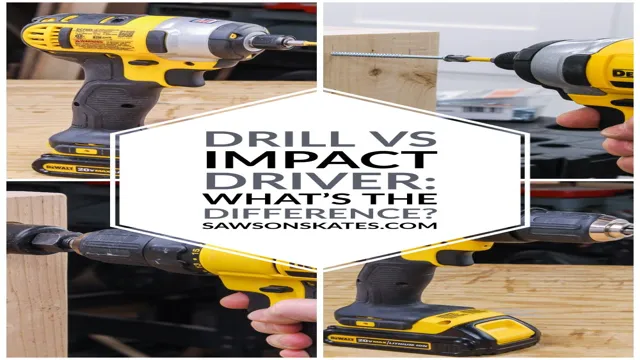
Benefits of Using an Impact Driver
An impact driver is a powerful tool that is designed to drive screws and bolts. Unlike a regular drill, it delivers forceful blows of torque to the screw or bolt, providing greater control and precision. The main benefit of using an impact driver is that it makes the driving process much faster and easier.
With its powerful torque, an impact driver can effortlessly drive screws and bolts through the toughest materials, such as wood, metal, and concrete. It’s also much more comfortable to use than a regular drill, as it requires less force on the user’s part and produces less vibration. Additionally, an impact driver can be used in tight spaces and awkward angles, making it a versatile tool for any DIY enthusiast or professional.
Overall, an impact driver is an excellent investment for anyone who wants to save time and effort when driving screws and bolts.
What is a Drill?
When it comes to tools for DIY projects or home repairs, drills and impact drivers are often on the top of the list. But what exactly is the difference between these two tools, and why would you choose an impact driver over a drill? Well, here’s the big difference: a drill is great for drilling holes and driving screws into softer materials like drywall or wood. An impact driver, on the other hand, is designed specifically for driving screws into harder surfaces like metal or concrete.
The main advantage of using an impact driver over a drill is its bursting power, which makes it easier and faster to drive screws with less effort. So, if you are looking for a tool that can handle tough jobs with ease, an impact driver is definitely the way to go. Trust me, once you try one out, you’ll never go back to using a drill for your heavy-duty projects!
How Does a Drill Work?
A drill is a useful power tool that rotates a bit or drill bit to create holes in various materials such as wood, metal, plastic, or concrete. It is commonly used for DIY projects, construction, and woodworking. The drill works by applying force to the material to create a hole.
When the drill is turned on, the motor inside rotates the chuck, which holds the drill bit. As the drill turns, the bit cuts into the material, creating a hole. The speed of the drill can be adjusted to make the hole larger or smaller, and the depth can be controlled by the user.
A drill is an essential tool in any workshop or construction site and can make a variety of tasks much easier and faster. Always remember to wear proper safety gear, like goggles and gloves, when using a drill to prevent any accidents.
Advantages of Using a Drill
A drill is a versatile tool that can be used for a variety of tasks, such as drilling holes, making indentations, and even mixing paint or concrete. There are many types of drills, such as cordless, electric, and wired, each with its own advantages and disadvantages. One of the main advantages of using a drill is its efficiency, as it allows the user to complete tasks quickly and easily.
Additionally, drills are very precise and can be used for intricate tasks that require accuracy and attention to detail. Another advantage of using a drill is its versatility, as it can be used on a wide range of materials, from soft wood to metal. Furthermore, drills are very durable and can be used for many years without needing to be replaced or repaired.
Overall, using a drill can save a lot of time and effort when completing tasks, while also providing accuracy and versatility. Whether you’re a professional contractor or a DIY enthusiast, a drill is an essential tool that should be a part of every toolbox.
When to Use a Drill
A drill is a versatile tool that is widely used by professionals and DIY enthusiasts for both woodworking and construction projects. It is essentially a power tool that works by rotating a drill bit at high speeds, allowing it to bore holes into various materials such as wood, metal, and concrete. Drills come in various types, including corded drills, cordless drills, hammer drills, and impact drivers.
Cordless drills are popular due to their portability, making them suitable for outdoor work and remote locations. On the other hand, corded drills are more powerful and are ideal for heavy-duty drilling tasks. Knowing which type of drill to use depends on the project you are working on and the specific requirements of the task at hand.
Thus, it’s important to have a good understanding of the capabilities and limitations of each type of drill. By selecting the right drill for the job, you can ensure efficient and accurate results, saving you time and effort.
Why Choose an Impact Driver Over a Drill?
If you’re looking for a powerful tool to handle heavy-duty tasks, an impact driver might be a better choice than a drill. While both tools can drill holes and drive screws, impact drivers offer greater torque and speed. One big difference between the two is the way they work.
A drill spins the bit, applying constant force to the material being drilled. In contrast, an impact driver uses bursts of rotational force to deliver greater torque and speed. This additional force makes it easier to drive screws into tough materials like hardwoods or metal, as it can power through resistance that might stall a drill.
Additionally, the design of an impact driver is often more compact, making it easier to handle in tight spaces. Overall, an impact driver is an excellent choice for any DIY project or renovation work that requires more power and speed than a drill can offer.
Speed and Power
When it comes to DIY projects or professional construction work, having the right tool for the job is crucial. While both drills and impact drivers can be used for driving screws and drilling holes, an impact driver offers several advantages over a drill. Firstly, an impact driver is far more powerful than a drill, providing more speed and torque.
This means it can handle tough jobs where a drill would struggle, such as driving long screws or working with thick materials. Secondly, an impact driver can work faster than a drill due to its unique hammering action. The impact driver delivers a series of quick bursts of power, allowing you to work more efficiently and complete tasks more quickly.
So, if you want to get the job done quickly and effortlessly, an impact driver is the way to go.
Ergonomics and Comfort
If you’re looking for a tool that’s comfortable to use and won’t cause strain in your wrist and arms, an impact driver is the way to go. Unlike drills, impact drivers deliver a strong, rotational force that helps to drive in even the most stubborn screws. And with the advancement in technology, impact drivers are becoming smaller and more comfortable to handle.
Impact driver’s compact design also makes it easy to reach tighter spaces that a drill might not be able to reach. However, it’s important to understand that an impact driver and a drill have different purposes. While a drill is ideal for drilling through soft and hard materials, an impact driver is the perfect tool for driving in large screws, bolts, and lag screws.
If you’re searching for a tool that offers power, durability, and ergonomic comfort, an impact driver is definitely worth considering.
Conclusion
In the battle of drills versus impact drivers, it’s clear that impact drivers come out on top. With their ability to effortlessly power through even the toughest materials, and their unique impact mechanism that reduces the strain on your wrists and arms, impact drivers are simply a cut above the traditional drill. So the next time you’re faced with a tough job, skip the drill and grab an impact driver – your arms (and your sanity) will thank you.
“
FAQs
What is the main difference between an impact driver and a drill?
The main difference between an impact driver and a drill is that an impact driver delivers rotational force in addition to linear force, making it more powerful and better suited for driving screws and other fasteners.
Can I use an impact driver to drill holes?
While an impact driver can technically be used to drill holes, it is not recommended as it may damage the bit or the driver itself. It’s best to use a drill for drilling tasks.
How does an impact driver help with efficiency and speed?
An impact driver can help with efficiency and speed because of its ability to deliver more torque with less effort. This means you can complete jobs faster and with less fatigue.
What type of projects is an impact driver best for?
An impact driver is best for projects that require a lot of screwing, such as building decks or assembling furniture. It is also good for working with tough materials like metal or dense wood.
Do I need to buy special bits for an impact driver?
While you don’t necessarily need to buy special bits, it is recommended to use impact-rated bits to ensure they can withstand the higher torque of the driver.
Can I use an impact driver for automotive projects?
Yes, an impact driver can be useful for automotive projects like changing tires or working on engines. Just be sure to use the proper torque settings to avoid damaging parts.
Why should I choose an impact driver over a drill?
You should choose an impact driver over a drill if you need more power and torque for driving screws and fasteners. It can help you work faster and more efficiently, especially for larger projects.

